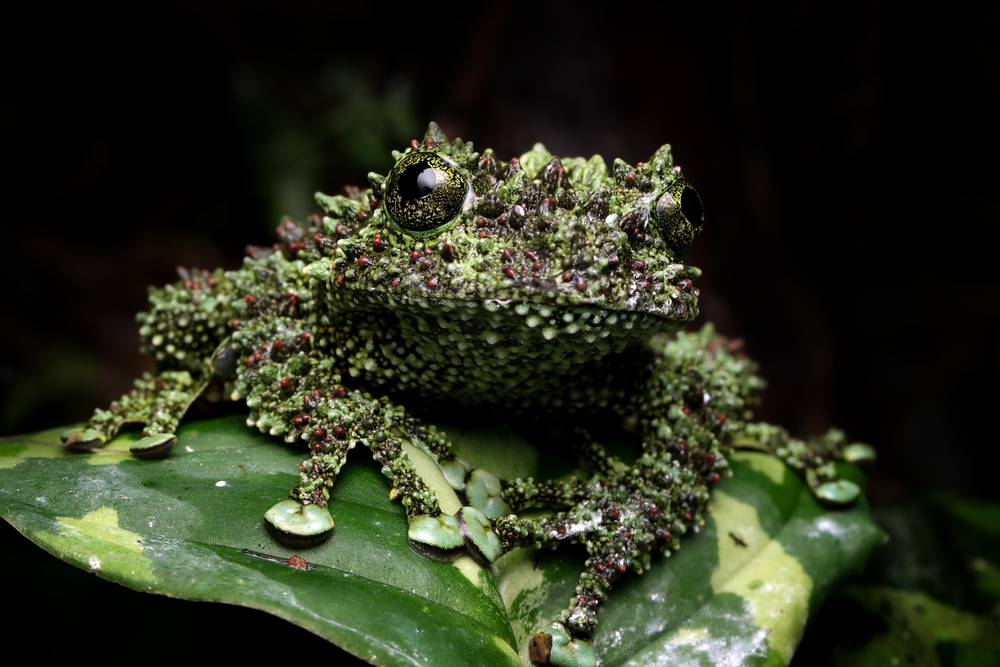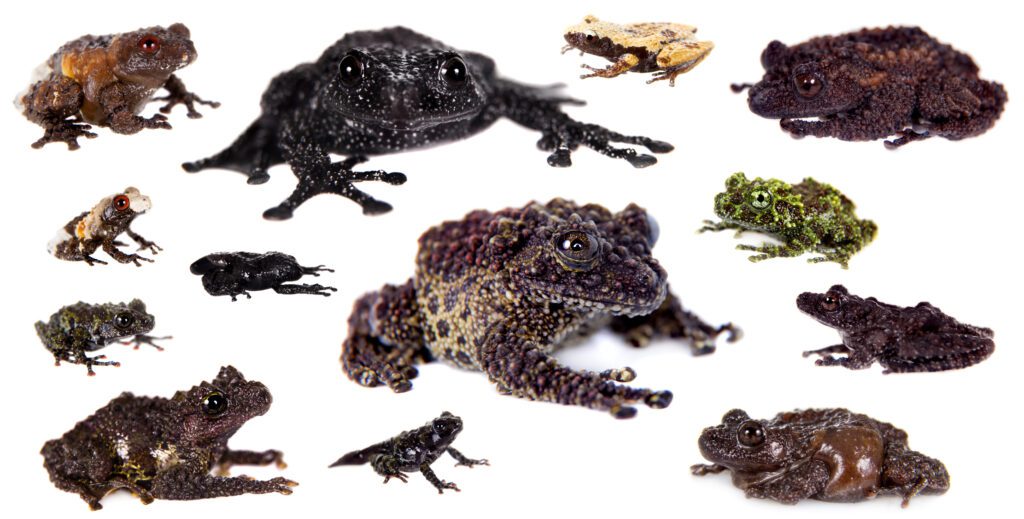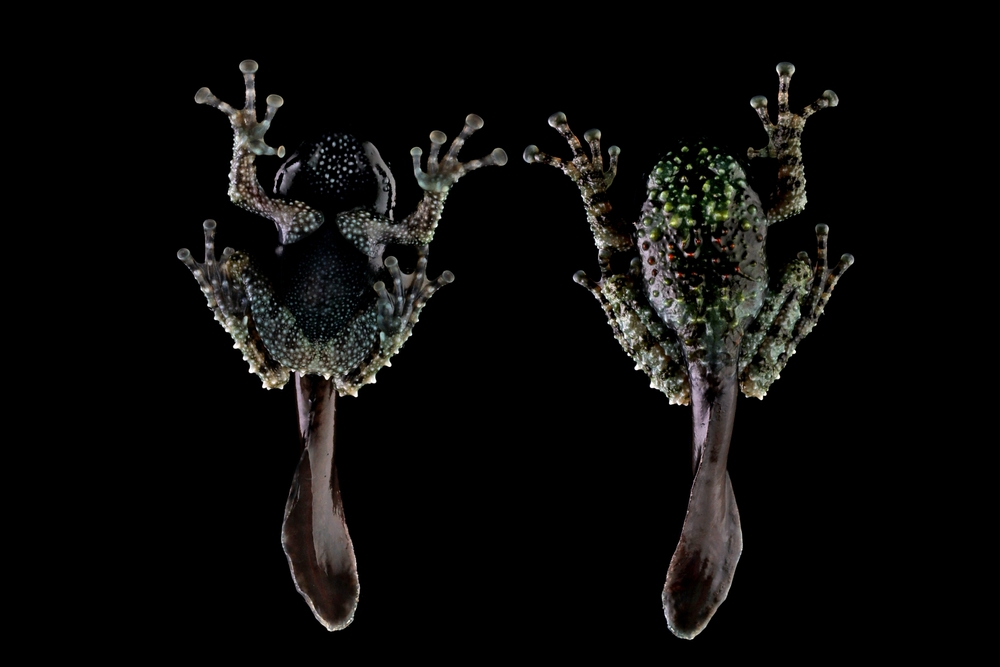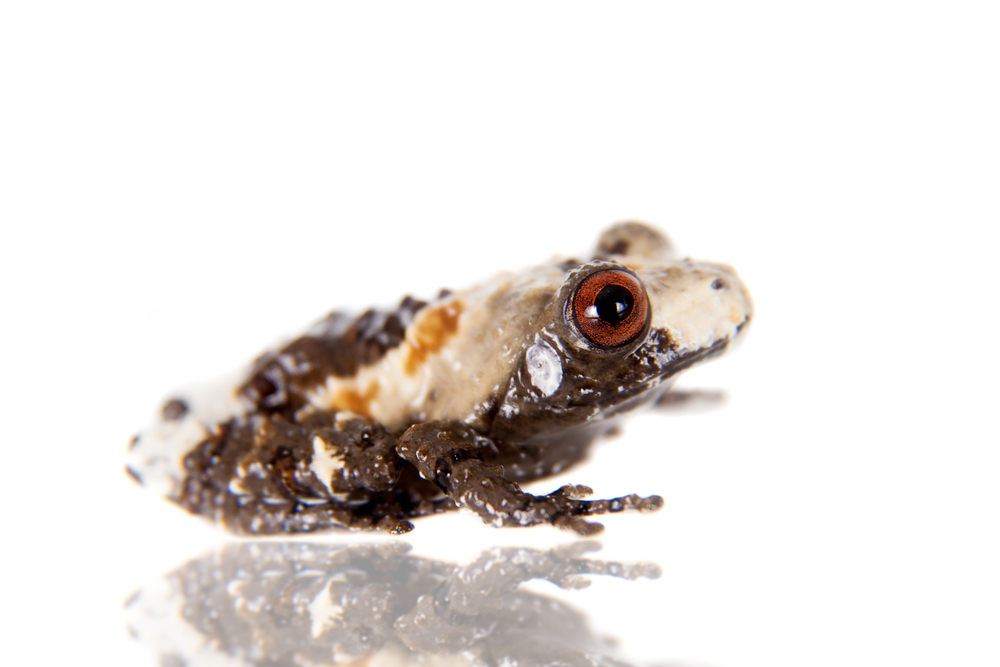With many tree frogs spending almost all their lives on mossy branches, it makes sense that countless species across the world would evolve camouflage to mimic moss. The mutable rain frog (Pristimantis mutablis) of South America can change the texture of its skin to blend with specific mosses. The hollow-snouted shrub frog (Pseudophiliatus cavirostris) has uniquely warty skin to blend with the moss growing in tree hollows. Even terrestrial frogs, such as Scaphiophryne spinosa of Madagascar, have developed spiny appearances to blend with moss on the forest floor. However, no genus does moss mimicry quite like the “mossy frogs” of the genus Theloderma from South East Asia.

Theloderma Species
There are over 30 species of frogs in the genus Theloderma (which translates to ‘nipple skin’), with new species being described quite frequently and as recently as 2022. The diversity of these species is partly due to their wide distribution throughout Asia, from northeastern India through to South China and as far south as the Sunda Islands in Indonesia. Within this range, some species are also well adapted to high-elevation habitats, meaning certain populations will be isolated to mountain ranges. Other species within the genus are restricted to lowland habitats.
This wide spectrum of diversity, coupled with an ecological reliance on pristine habitats in hard-to-reach areas, means research into the natural history and behaviours of mossy frogs is still somewhat limited. This sparked huge controversy around their placement in private herpetoculture, within the last decade. However, recent conservation assessments of the most popular species; T. corticale, T. asperum and t. bicolor lists all three species as “Least Concern” on the IUCN Red List. Unfortunately, all species population numbers are in decline and a high demand for mossy frogs may prompt unsustainable harvesting of other Theloderma species (either accidentally, or to expand collections). Today, the three most popular species are frequently bred in captivity and whilst they may still be slightly seasonal in their availability, countless hobbyists are breeding these charismatic frogs to reduce pressures on wild populations.

Part of the reason hobbyists are so successful with breeding Theloderma is their rapid development cycle. Because mossy frogs are entirely arboreal and conspecific with various foam-nesting species, they have evolved a method of egg-laying that sees them utilise tree hollows. The tadpoles hatch into tiny pools of water within the trunk, which can quickly dry up if rain isn’t frequent or heavy enough to replenish them. They therefore grow fast without even feeding, until they emerge as young froglets. This is a similar breeding strategy to the cinnamon tree frogs (Nyctixalus) that are also now reasonably common in captivity. It is this breeding strategy that has allowed Theloderma to colonise a wide range of very wet habitats across Asia.
Vietnamese Mossy Frog (Theloderma corticale)
The Vietnamese or ‘Tonkin’ mossy frog (Theloderma corticale) is perhaps the most well-known of the Theloderma species in captivity. It is also one of the most striking in appearance and it, alongside T. bicolor is the most “moss-like” of all the mossy frogs.
The Vietnamese mossy frog has a relatively wide distribution from Guangxi in southern China, into Laos and northern Vietnam. Here, it is found close to streams in tree hollows and root systems, as well as cave cavities. In captivity, many hobbyists report the species as semi-aquatic and spending most of its time in water. Whilst this may also be true in the wild, the animals are possibly resting in tannen-rich temporary pools of water within logs and tree trunks, as opposed to beautiful clear streams or ponds. Either way, a paludarium-style setup is a great option for keeping these frogs and if it happens to be beautifully-constructed, even better.
A ”drip wall” water feature is encouraged for a paludarium setup. Within caves, consistent water flow creates moss that acts as the perfect refuge for these frogs. Simulating this in captivity is quite simple if the keeper installs a water filter that brings the reservoir of water from the bottom, up to a nozzle at the top, that drips down some décor. Artificial rock is a good surface, as is cork bark, although the keeper should expect the bark to rot after a few years and the entire terrarium may require re-building.
Vietnamese mossy frogs are found at medium altitudes from 470 – 1500m above sea level in a surprisingly temperate region of Asia. They prefer cool temperatures and do not tolerate extreme heat. This is the biggest challenge for most keepers, as the frogs should be kept 15 – 21℃. Anything higher than 25℃ is a cause for concern. Furthermore, northern Vietnam experience seasonality, with cool, dry(ish) periods and warmer wet seasons. The mossy frogs actively avoid these extremes by remaining close to water-rich areas and in high-humidity tree hollows year-round. Therefore, humidity should stay above 80% at all times and temperatures can fluctuate throughout the year within the species’ comfortable parameters. Mossy frogs are primarily nocturnal, so a Ferguson Zone 1 UVB Eco T5 is suitable for providing the small amount of UVI required to maintain circadian rhythms and operate naturally.
A misting system should be used for these frogs so they can be misted with cool water frequently. This will help reduce the temperature in the enclosure. On exceptionally hot days, freezing some R/O (or at least treated) water and adding some ice to the paludarium water can help reduce the temperature in the drip wall. Also, placing an ice pack in front of the vivarium and using a fan to blow cool air into the enclosure is a good last-minute strategy to reduce temperatures.

Bird Poo Mossy Frog (Theloderma asperum)
The ‘Garden Hill’, ‘pied’ or ‘bird poo’ mossy frog is a much smaller, but equally as unique species of amphibian that is frequently available captive-bred in the UK. These mossy frogs are more variable than the Vietnamese mossy frogs but begin life as tiny, smooth, tan-coloured tree frogs. As they age, their striking red eyes, contrasted patterns and warty limbs become more prominent. As the name suggests, their ivory dorsum is adapted to look like bird poo.
Theloderma asperum is one of the more widely distributed species. Official records have found the species in Malaysia, Thailand, Bhutan and Bangladesh with the IUCN suggesting the species is also found in Nepal. Anecdotal reports from herpers also point towards populations in Vietnam where it is thought to inhabit the same forests as the Vietnamese mossy frog. However, its likeness to T. albopuntatum and T. baibungense casts speculation over this. There may also be populations in Indonesia and Cambodia. Of course, the excellent camouflage of this species combined with a general lack of information on the genus itself means its distribution is uncertain. Where T. asperum has been recorded, it inhabits tropical lowland and submontane rainforests from 0 – 1,500m above sea level. This makes it a far more heat-tolerant mossy frog species than T. corticale or T. bicolor.
Husbandry should be similar to that of other mossy frogs, although temperatures can reach 24℃ with no ill effects (anything higher than 27℃ can be fatal). There may also be an argument for not requiring a full paludarium setup for this species which is more versatile in its habitat usage than other species of mossy frogs. However, a pool of clean, filtered water is recommended and therefore, an attractive paludarium setup is usually the go-to for most keepers.
Bird poo mossy frogs only grow to a few centimetres in length, making them amongst the smallest of the Theloderma species. Therefore, a small colony of mossy frogs can be housed comfortably in a 45cm3 glass terrarium. They are possibly the most manageable of the mossy frogs from a captive husbandry perspective, but do have a reasonably loud call that new hobbyists should be considerate of.

Chapa Mossy Frog (Theloderma bicolor)
The Chapa ‘bug-eyed’ or ‘mossy’ frog is one of the more controversial species within the trade. It occurs in submontane forests between 1,400 and 1,800m in elevation in northwestern Vietnam and China. It has a reasonably small distribution and relies on very specific habitats to thrive which, until 2022, meant conservationists considered this species to be Endangered. Surveys into habitats where it had been completely lost (possibly driven by the spread of Bd alongside deforestation) painted a bleak picture.
This meant that when many T. bicolor specimens started showing up in captivity alongside the already popular T. corticale, conservationists were considered that it was being harvested at a potentially unsustainable rate. Later surveys into remote areas of southern China found the expected distribution of the species to be larger than initially thought and whilst it has suffered severe declines in Vietnam, the population appears to be strong in China. Now, the Chapa mossy frog is listed as “Least Concern”. Furthermore, animals that were once exported from Vietnam are semi-frequently bred in captivity and the species has also been reported to have been bred in Vietnam too. T. bicolor, whilst less abundant than T. corticale and T. asperum in the UK and Europe can be sourced and bred in captivity without impacting wild populations.
The husbandry of these mossy frogs is like other Theloderma species; a suitably sized, well-maintained paludarium with cool temperatures and plenty of vegetation. However, being a specifically submontane species, they are less tolerant to climate fluctuations and perhaps more fragile than the other two species listed in this article. Keepers should try to keep temperatures between 16 – 20℃. The species also occurs in a range of habitats but is typically found on broad-leaved plants close to trees in evergreen forests. Therefore, a large densely-planted paludarium is required. Some species have also been found in limestone karsts, so an artificial rock wall with dripping water is also a good addition.
Diet, as with all species of Theloderma should consist of a wide variety of suitably-sized insects. Alternating supplements between calcium with D3, multivitamins, bee pollen and preformed Vit-A (with calcium being the most frequently used) is a good way to ensure a varied nutritional profile. Insect species offerings should be equally as varied and comprise of crickets, locusts, calci–worms, waxworms, silkworms, silk moths, black soldier flies, curly wing flies, snails and more.

Mossy Frogs in Captivity
Mossy frogs are undoubtedly more advanced than other tree frog species. They are more susceptible to overheating and even the concept of building a paludarium requires a slightly more advanced knowledge of terraristiks, as well as aquatics. However, this is a welcome challenge for many hobbyists eager to keep some of the most marvelous amphibians on Planet Earth.